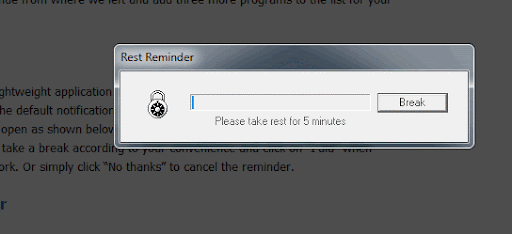
Depending on the number of LEDs in your strip/ring you may need to edit. This setup script did most of the hard work, and I recommend giving it a go if you need to control WS2812B LEDs, it comes with some great examples.
Desk break reminder software#
To get the Pi to work with the NeoPixel ring I first installed some software for a board based on the same kind of LEDs (The Unicorn HAT): curl -sS | bash GPIO12 (Input) - Original Button GPIO16 (Input) - Handset Receiver Switch GPIO14 (Output) - Original Phone Buzzer GPIO26 (Output) - LED for lamp First I secured the Raspberry Pi board in place with some sticky-bolts (3m cable tie holders with small bolts drilled through) and then wired up the pieces to the GPIO one by one.Īpart from the NeoPixel ring, which was wired up to 5v, GND and GPIO18, the components were set up as follows: I'd used quite long jumper cables on all the switches, so assembly wasn't too difficult. I was a bit unsure of the buzzer, as it was marked "12v" - I considered using a small relay board and a 9v battery, but then after testing I realised it would beep quite nicely at 3v, so wired it directly to jumper cables. Next I wanted to be able to lift the phone's handset to reset the break timer, so with a multi-meter set to "resistance" I began testing different combinations of the original screw connections on the phone, eventually stumbling over a pair of terminals that would connect directly to the receiver switch. The small red lamp was a little trickier, but just needed to have its bulb replaced with a white LED, otherwise the holder was all left intact, again wired up to jumper cables. The original button was the easiest, this turned out to be an early micro-switch, with screw terminals, so it was easily connected up to some female jumper cables. In case you can't see the embedded YouTube video it's at Īfter a quick dismantle and scrub-up, the telephone parts were much more approachable, and I set to getting them connected up with the Raspberry Pi. It's powered from a USB hub on my work laptop, and boots up automatically when I start up in the morning, so there's nothing to do but reset the timer when I take a break. The whole thing is powered by a nice old Raspberry Pi 2, using the phone's original switches and buzzer alongside the neopixel ring. To cancel the beeping or reset the timer at any time I just need to either press the button on the phone or momentarily lift the handset - both of which force me to get up and walk across the room, then seeing as I'm up anyway I may as well stretch my legs, grab a coffee.you see how it works.


Ignore the rainbow and the LED ring starts flashing red, accompanied by a subtle but un-ignorable beep from the phone's original buzzer unit. This old and unusual dial-less telephone now helps well-being and productivity to co-exist in the home office! Beneath its vintage grille a neopixel ring lights up its 24 LEDs in sequence for an hour, switching to an eye-catching rainbow display when it's time to take a break.


 0 kommentar(er)
0 kommentar(er)
